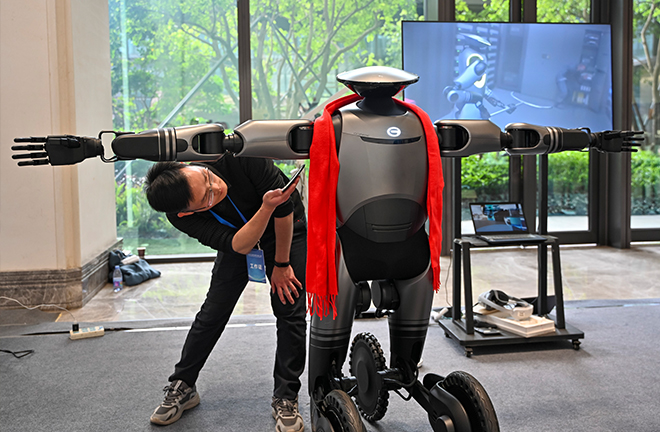Int’l scholars highlight China’s tech edge

An engineer debugs a humanoid robot during the Guangdong Provincial High-quality Development Conference, which was held on Feb. 5, 2025, in Guangzhou. Photo: IC PHOTO
In 2024, China made remarkable breakthroughs in scientific and technological development, exemplified by such achievements as the return of the Chang’e-6 lunar probe carrying the first-ever samples from the moon’s far side, the debut of “Origin Wukong,” the country’s third-generation superconducting quantum computer, and the sea trials of the Fujian aircraft carrier. These advancements have attracted growing interest from the global academic community, underscoring China’s expanding role in scientific and technological innovation.
Indicators of technological strength
James Laurenceson, a professor and director of the Australia-China Relations Institute at the University of Technology Sydney in Australia, recently told CSST that while China has the capacity to assume global leadership in technology, few recognized it and associated the country with high-tech and innovative products.
“In a recent co-authored study, I argue that a confluence of three major factors—the ongoing growth of China’s domestic market, the government’s relatively unfettered capacity to enact industrial policy that favors what it calls ‘indigenous innovation,’ and broader forces associated with globalization such as mergers and acquisitions (M&As) and cross-border transfers of human capital, knowledge, and technologies—has China poised to become the world’s leading producer and exporter of technology,” Laurenceson remarked.
Laurenceson identified four useful criteria for assessing technological leadership, including research and development (R&D) intensity, which measures absolute R&D expenditure and facilitates international comparisons; the total number of R&D personnel, which reflects a country’s human resource commitment to R&D; the number of scientific publications and their citation frequency, indicating the contributions of a country’s scientists and engineers to relevant knowledge creation; and the number of patents filed under the Patent Cooperation Treaty, which indicates the extent to which innovations become practical and ultimately find commercial application.
“Based on these criteria, there is strong evidence that China has been developing its scientific, technological, and innovation capacity at a pace that will enable it to become the global technology leader in the coming decades,” he asserted.
Laurenceson elaborated that the skepticism surrounding China’s technological prowess often overlooks the three factors that provide the country with the resources and competitive edge necessary to eventually assume global technology leadership: its growing domestic market; the Chinese government’s ability to introduce diverse industrial policies and measures tailored to the country’s developmental needs, and its capacity to leverage its growing role in international markets to acquire advanced technologies while increasing its capacity to undertake advanced R&D.
“Market size has long been associated with innovation, and China’s market size gives Chinese firms many innovation advantages,” echoed Damian Tobin, a senior lecturer from the Business School at Cork University in Ireland, during a recent interview with CSST.
“At the same time, Chinese firms are producing manufactured goods on a broad scale, having assumed global leadership in steel, cement, automobiles, fertilizer, and many other products that are now entering export markets,” Tobin continued. Partnerships with foreign firms generate technology spillovers that accelerate innovation and high-tech development.”
Tobin pinpointed globalization as the other factor contributing to China’s competitive advantage on its technological development. Amid economic globalization, Chinese enterprises have greater opportunities for overseas collaboration, advancing technological innovation through acquisitions, joint research, and other initiatives.
New quality productive forces
Commenting on “new quality productive forces,” a novel strategy promoted in China, Tobin said that it prioritizes the development of specific technologies identified by the state over traditional GDP growth targets, implying that technological progress itself can serve as a driver of economic growth.
“Technology is in itself a ‘new productive force’ in addition to the classical factors of labor and capital, and technological innovation, can in turn, spawn additional ‘new productive forces,’” said Laurenceson, adding that the China-proposed new quality productive forces not only integrates market forces, but also combines Marxist theory of productive forces with Chinese practices.
Laurenceson elaborated that the goal of developing “new quality productive forces” is to achieve disruptive breakthroughs and incremental improvements in existing technologies. “The implication is that while previous industrial policy efforts mainly focused on achieving competence, self-sufficiency, or global market share in established technologies, the new generation of industrial policies must focus on ‘future industries’ that are nascent or do not yet exist, such as humanoid robots, nano-manufacturing, quantum computing, nuclear fusion, hydrogen energy, exploration of the moon and Mars, deep-sea mining, and genetic engineering.”
He also pointed to institutional reforms supporting this shift, such as the establishment of the Central Science and Technology Commission to coordinate national innovation efforts, increased funding for basic scientific research through competitive grants, and improved coordination between the public and private sectors via a revamped system of national laboratories and innovation centers.
China has already seen promising results in building institutions to support new quality productive forces, securing technological advantages in areas like solar energy, wind power, and electric vehicles. The country’s increasingly diversified manufacturing ecosystem, combined with a vast pool of skilled labor, is expected to enhance systematic coordination and yield stronger outcomes in basic research.
Edited by CHEN MIRONG
